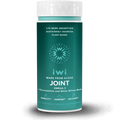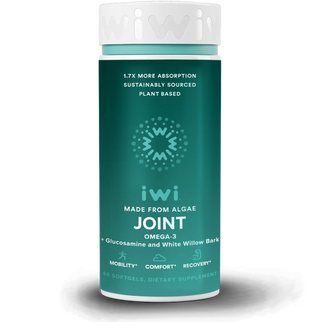Your joints keep you in motion, so they deserve to be supported. With all of the work they do, your joints can be subject to a lot of wear and tear, affecting their strength and mobility. As a result, you should be mindful of how to care for these important parts of your body. Because your joints work hard, you should be as proactive as possible to protect them before problems arise.
Fortunately, by incorporating healthy habits and certain practices into your day, you can support your joints and positively impact their overall function, strength, and mobility. iwi life is here to provide you with the information you need to know about your joint health and how you can support it.
What Is a Joint?

We know that we have joints and probably hear about the importance of protecting them, but that does not mean we fully understand what a joint is. A joint is any part of the body where two or more bones meet.
Joints are made up of several important parts that give them support and allow them to function. The components of a joint are:
- Cartilage: Cartilage is the tissue that covers the surface of a bone at a joint and reduces friction during movement within a joint.
- Ligaments: Ligaments are bands of connective tissue, like elastic, that connect bones together, provide support, and prevent excessive movement.
- Tendons: Tendons are another type of connective tissue that connect muscles to bones. They help control the movement of the joint.
- Bursae: Bursae are fluid-filled sacs that exist between the bones and ligaments to help provide a cushion against the friction of a joint.
- Synovial Membrane: This is a type of tissue that lines the joint, seals it, and lubricates it with a fluid called synovial fluid.
There are several types of joints in the body, defined by their appearance and how they work. These types can be broken into two categories — fixed joints and mobile joints.
Fixed joints are joints that do not move, while mobile joints are those that do. Mobile joints are the most common type of joint in the body. Types of mobile joints are:
- Ball and socket joints, like the hip and shoulder joints.
- Hinge joints, like the fingers, knees, and elbows.
- Pivot joint, like the neck joint.
- Ellipsoidal joints, like the wrist joints.
What Conditions Can Affect Your Joints?
Your joints are susceptible to wear and tear over time, especially if you regularly engage in high-impact activities like sprinting, jogging, and jumping. Over time, we naturally lose some of the flexibility our joints once had, which can lead to feelings of stiffness.
Stiffness of joints is often more common in the morning or after long periods of inactivity. This condition starts by affecting the joints in your hands and feet but can spread to your larger joints.
How Can I Support Healthy Joints?
Ultimately, your joints take on a tall task by supporting your weight and keeping you mobile daily. As a result, it takes some mindfulness and consistent effort to support your joints and keep them working properly, especially as you age.
While there are some actions you can take now to support your long-term joint health, these are purely preventative. If you already have joint discomfort, you may want to discuss treatment options with a qualified healthcare provider.
That said, here are a few ways you can support your joints now for the long haul.
1. Engage in Physical Activity

Physical activity is one way to be proactive and support your joint health. Exercise can help your joints in several ways, such as supporting your joints and the ligaments and muscles that support them.
Try to choose low-impact exercises that are easy on your joints, like biking or swimming, instead of an exercise that is tough on your joints, like running.
2. Treat Your Joints Carefully
Although exercise is a great way to support and strengthen your joints, you should still be careful. A key part of exercising is performing movements correctly and making sure to warm up.
Overdoing strength training can strain your joints, while range-of-motion exercises can help support flexibility and relieve feelings of stiffness. A healthy balance of both is generally best practice to protect your joints. In the end, it is all about paying attention to what your body needs and responding accordingly.
If you are dealing with consistent joint discomfort or a condition that is specifically affecting your joints, you may benefit from physical therapy. Physical therapy uses exercise to help address joint discomfort. If you experience an injury like a sprain, you may want to discuss the possibility of physical therapy with your primary care provider.
3. Maintain a Healthy Diet
In addition to exercise, a healthy diet is another important way to support your joints. A healthy diet is particularly important because maintaining a healthy weight is a crucial part of supporting your joints.
Being overweight can cause extra stress on your joints as they work harder to support the additional pounds. By eating right and avoiding foods that can lead to weight gain, you can avoid putting unnecessary pressure on your joints and reduce some risk factors that can lead to joint damage.
Obtaining a variety of nutrients can go a long way to providing your joints with the nutrition they need to stay strong and mobile. Including vitamins, minerals, and antioxidants in your diet is a great way to support healthy aging and promote strong, healthy tissues.
4. Get More Calcium

Calcium is a well-known nutrient for supporting healthy, strong bones. Unfortunately, not everyone gets all of the calcium they should throughout the course of the day. Without enough calcium, your bones and joints can weaken over time, so you should be mindful of your daily calcium intake.
The daily recommended intake of calcium is about 1,000mg for adults over 18. After age 50, women should increase their intake to about 1,200 mg each day, and men should do the same after age 70.
Excellent sources of calcium include dairy products, some fish, and tofu, as well as fortified drinks like almond milk, soy milk, and orange juice. Green vegetables like spinach, kale, and broccoli also contain admirable amounts of calcium.
Your body relies on vitamin D to support calcium absorption, so make sure that you include it in your daily nutrition as well. Sources of vitamin D include salmon, fortified drinks and juices, and the sun.
5. Incorporate Omega-3s
Nutrition plays an important role in supporting your joints, and calcium is not the only important nutrient. Omega-3 fatty acids can support your overall joint health. The two most important omega-3 fatty acids are DHA and EPA, which can support healthy joints and may temporarily soothe joint discomfort.
The good news is that omega-3s also provide a wealth of additional benefits. These essential nutrients help support healthy blood pressure, brain health, and overall heart health, just to name a few.
The most common source of DHA and EPA is fatty fish, like salmon, sardines, mackerel, and tuna. Many people also turn to fish oil or krill oil supplements for additional sources of these two fatty acids. However, not everyone can or wants to incorporate fish into their diet due to allergies, taste, or environment and animal welfare concerns.
Fortunately, iwi life provides an effective omega-3 joint supplement that uses the power of algae to provide DHA and EPA fatty acids. This supplement is entirely plant-based, so it is great for anyone on a plant-based diet.
iwi life’s joint supplement also includes a range of other nutrients that can support your joints, like a vegan form of glucosamine — typically derived from shellfish — along with curcuminoids and salicin from white willow bark. Including just two softgels a day into your routine can give you your recommended intake of essential fatty acids.
Start Supporting Your Joint Health Today
It is never too early to start taking care of your joints. Taking steps to support your joints today can help reduce your discomfort down the road. If you are already experiencing joint discomfort, you may want to consult your primary care provider about treatments.
At iwi life, we strive to provide you with an easy way to give extra support to your joints and maintain mobility. Our joint supplement can help. This nutrient-packed supplement is rich with omega-3s, as well as other nutrients that support joint health, like glucosamine HCL for joint strength and curcuminoids to soothe joint tension. Experience the benefits for yourself by trying our Joint supplement today.
Sources:
Anatomy of a Joint - Health Encyclopedia | University of Rochester Medical Center
22 Calcium-Rich Foods | Cleveland Clinic



















